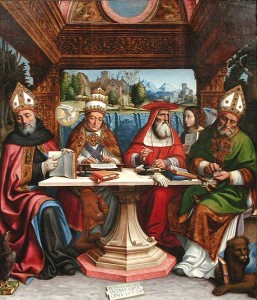
Sitting as it does at the heart of the western tradition, the Bible has for centuries inspired countless displays of artwork, from stained glass to epic poetry to oratorio. Although these examples of human creativity span a vast geographic and chronological spectrum, they often employ a surprisingly consistent set of symbols. In other words, they speak in a certain language, which can be traced through the centuries and across continents.

One clear example is the recurrence of the symbols assigned to the four evangelists (Matthew, Mark, Luke, and John). If you’ve ever been to a medieval church, such as the Basilica of San Vitale in Ravenna (top of page), or looked at an illuminated manuscript such as the famous Lindisfarne Gospels from Northumbria, you will perhaps have noticed that the authors of the four gospels are regularly depicted, and they are almost never alone. Matthew, Mark, Luke, and John are nearly always accompanied by four distinct creatures.
The usage of these images goes back ultimately to Irenaeus (d.202), one of the most famous theologians of the early church. Against heretical groups that used only one of the four gospels, Irenaeus insisted that you had to have all four to get a complete picture of Jesus (Against Heresies 3.11.8). To support his argument he relied upon the presence of the four living creatures around the throne of God, as recorded in Revelation 4:6-7. The first creature, which was like a lion, represents, according to Irenaeus, the Gospel of John, which begins with a notable emphasis on the divinity of Jesus. The second creature, which was like an ox, is aligned with the Gospel of Luke, since Luke begins with the story of Zechariah the priest in the Temple where animal sacrifices were made. The third creature around the throne had the face of a man, so Irenaeus said this represented the Gospel of Matthew, which begins by tracing Jesus’ earthly lineage back to David and Abraham. Finally, the fourth creature was like an eagle in flight, which is linked to the Gospel of Mark, since Mark begins with a quotation from the prophet Isaiah.

Although in the later patristic and medieval tradition some of these symbols are switched around (e.g., Jerome assigned the lion to Mark and the eagle to John), Irenaeus’ linking of the four creatures from Revelation 4 to the four gospels proved to be very influential for later Christian artwork, as it was taken up by scores of artists throughout Europe and beyond. Irenaeus creatively used these four creatures surrounding the throne of God to symbolize the four gospels, all of which tell the story of Jesus as the hope of human salvation. The ongoing representation of the four evangelists with these four creatures continues to emphasize that the church relies upon not just one, two, or three, but four gospels which testify to the saving life of Jesus.